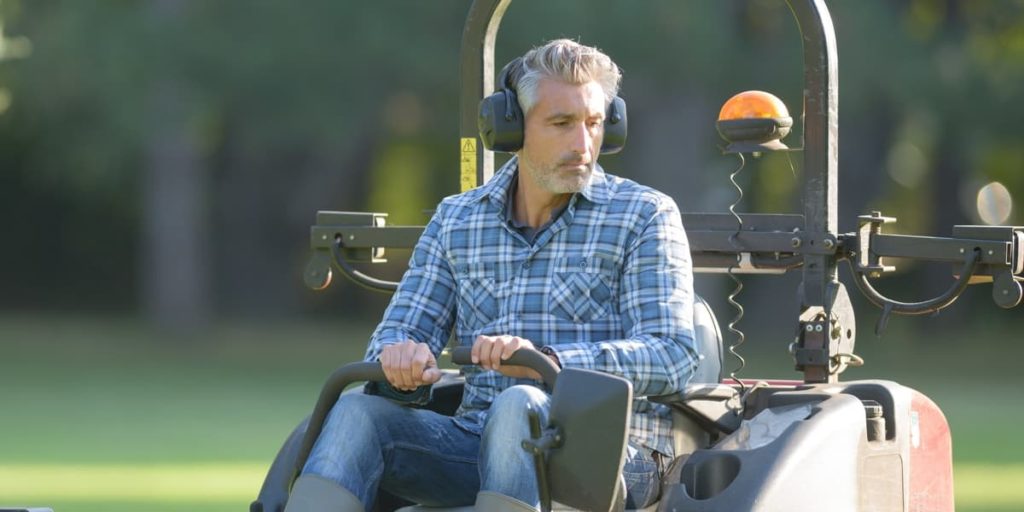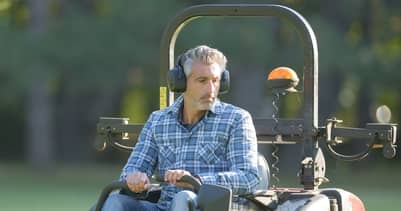Many of my friends and family unknowingly put themselves and their families in dangerous situations while operating their zero-turn mowers. While working in the lawn care industry and learning about other’s injuries while mowing,
I understand the importance of learning to operate mowers safely. I hope sharing my mowing experience and safety tips will help you minimize the dangers of zero-turn mowers and reduce the risk of injury.
Zero-turn mowers are dangerous because they are engine powered, move fast, turn quickly and have the potential to roll over when operating on hills, uneven terrain, near water sources, and retaining walls.
There are safety measures to take that will greatly decrease your risk of injury while operating a zero-turn. Just because zero-turn mowers appear to be less dangerous than larger machinery like tractors, skid steers, and excavators it doesn’t mean they are.
A zero turns compact size may make the machine appear less intimidating, however, you must educate yourself on how to operate machinery safely whether it’s a large machine or a small machine.

This post may include affiliate links. Purchases made through these links may provide a commission for us, at no extra cost to you. As an Amazon Associate, we earn from qualifying purchases.
Follow all safety instructions provided in your equipment operator’s manual prior to diagnosing, repairing, or operating.Consult a professional if you don’t have the skills, or knowledge or are not in the condition to perform the repair safely.
Mowers Send Consumers to the Hospital
My friend’s child chose to jump off a mower while it was running. I can’t imagine the horror as his child screamed in pain. The small child ended up slipping and had his foot land under the mower deck.
The blades cut off a large portion of his foot. Not only is his dad in agony because of the situation, but the child has to live with the injury for the rest of his life. This injury could have easily been prevented.
How many times have you seen a parent riding on a lawn mower with a child on his or her lap? Living in a suburban area, I have seen this more times than I should have. Some parents act like it’s an amusement ride for the kids with no concern for the child’s safety.
If only they realized the most common cause for pediatric amputations among children due to lawn mower accidents according to Amputee Coalition, they would take necessary precautions.
According to the Consumer Product Safety Commission (CPSC) an estimated 35,000 consumers were treated in the hospital emergency room between 2012-2014 for injuries related to riding mowers.
They also reported there was an average of 90 consumer deaths per year related to riding mowers between 2008-2010. Many of the deaths occurred from the victim falling off the machine, falling under the machine, or being run over by the lawn mower.
Lawn Mower Deaths
The Occupational Safety and Health Administration (OSHA) documents 16 deaths in 2019 and 19 deaths in 2018 as a result of operating a lawn mower in addition to numerous injuries. These are employee deaths while operating lawn mowers on the job.
Many of these employees worked for professional landscape companies or as grounds care staff for commercial or governmental facilities. Most deaths were the result of rollovers from operating on too steep of hills, close to embankments, or near bodies of water.
There were other deaths that resulted from not having safety protocols. One individual died after being thrown off of a lawn mower and run over with the blades engaged.
Operator presence controls were not available or possibly disabled which resulted in the mower blades staying engaged even when the operator was not in the seat.
How to Operate Zero-Turn Mowers Safely
- Do not operate on hills with slopes greater than 15 degrees. When operating a mower on steep hills you have a greater chance to roll over the lawn mower. Always drive up and down the slope of the hill and not across them.
- Do not operate your mower in wet conditions. Stay about from slopes when the grass is wet. The mower is harder to control in wet conditions.
- Stay away from bodies of water. Make sure you are staying a minimum of 5 feet from any bodies of water. It’s tempting to get as close as you can to a body of water to not have to spend as much time mowing these areas with an alternative cutting method.
It’s better to be safe and not find your mower laying in a body of water. Use a handheld trimmer or a push mower to mow these areas.
- Stay away from embankments, retaining walls, ditches, and any other quick changes in terrain. The same rule applies to bodies of water. Leave 5 feet of room between the mower and these items.
- Don’t change directions or speeds quickly. Making quick movements can make a mower unstable or cause you to lose control of the zero-turn. Always maintain steady speeds and movements.
- Do not operate with children, pets, or other people in the area. Mower blades spin very fast and can throw materials out of the discharge chute.
Rocks, stones, branches, and foreign materials left in the yard can easily shoot across the yard and injure those in the area. Stop the lawn mower if anyone enters the area.
- Do not discharge material toward a wall or other obstruction as material can ricochet back toward the operator.
- Disengage blades when not mowing. You will often times get off the mower to remove an obstruction, branch, or other debris. Each time you do this, make sure you turn off your blades before stepping off the lawn mower.
- Wear protective equipment while operating. This includes safety glasses and hearing protection. A gas-powered lawn mower emits a noise level of around 90 decibels.
Occupational Safety and Health Administration (OSHA) recommends hearing protection for those exposed to this level of sound.
- Wear the mower-equipped seat belt along with using the rollover protection structures (ROPS). Your mower needs to have either a fixed ROPS system or a foldable ROPS.
There may be times when you have to temporarily remove a fixed ROPS or fold over your foldable ROPS to get into areas with low-hanging overhead obstructions or obstacles.
As soon as you are out of areas with overhead obstructions, immediately reinstall your ROPS system. The ROPS system must be used with the seat belt to ensure safety.
This system prevents the operator from getting stuck or injured under the mower in the event of a rollover. Please note: if you have to remove or fold over your ROPS, a seatbelt should not be used.
- Never allow a passenger on your mower. It’s tempting to let your child sit on your lap when you mow, especially when there isn’t any additional adult supervision and you need to mow your lawn.
The best thing to do is delay cutting your grass until you have someone to supervise your child.
- Always operate during daylight
- Never leave your zero-turn mower unattended. Disengage the blades, set the parking brake, turn off the engine and remove the key.
- Wear closed-toe shoes. Never wear sandals while operating power equipment.
Safety Options Every Mower Must Have Installed
Before you purchase your next mower, make sure it has these important safety options installed on your zero-turn mower.
- Operators Presence Control System also known as the seat safety switch. This system shuts off the blades when the operator isn’t in the seat.
- Rollover Protection System (ROPS). This is a bar that sits above the operator station to protect the operator from getting crushed in the event of a rollover. This must be used with a seat belt in order for the ROPS to be effective.
- Seat Belt. The seat belt must be used with the ROPS system.
- Wheel Weights or Counter Weights When Necessary. Follow manufacturer guidelines when wheel weights or counterweights may be necessary. It is often necessary when running a rear-mounted bagger system.
- High Seat Back. Ensure your zero-turn has a high seat back to keep you from shifting in your seat.
Simple Checklist for Safety Before Each Lawn Mowing
- Remove sticks, rocks, toys, and other obstructions before mowing
- Remove people and pets from the mowing area
- Ensure the ROPS bar is in an upright position
- Seatbelt works
- Make sure blades are not damaged and cracked allowing for a piece of the blade to break off and eject from the mower deck. Read more about mower blade inspections here.
What Age Should a Child Start Mowing the Lawn?
The American Academy of Pediatrics recommends children should be at least 12 years old to operate a walk-behind push mower. The organization recommends children be at least 16 years old to operate a riding mower.
The ages provided are a guideline. As parents, you know the maturity of your child and when he or she is ready to operate equipment while maintaining safety.
A child must be able to follow rules, and safety procedures and be able to physically operate the mower. Some parents may feel their child is not ready to mow at these recommended ages. That’s okay.
Once you believe your child is ready to operate a lawn mower, make sure you go over all safety procedures including the dangers of reaching under the deck with the mower blades engaged.
